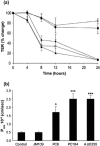Disruption of tight junctions during traversal of the respiratory epithelium by Burkholderia cenocepacia
- PMID: 16239504
- PMCID: PMC1273860
- DOI: 10.1128/IAI.73.11.7107-7112.2005
Disruption of tight junctions during traversal of the respiratory epithelium by Burkholderia cenocepacia
Abstract
Burkholderia cenocepacia is an opportunistic bacterial species capable of causing life-threatening respiratory tract infection in persons with cystic fibrosis (CF). Unlike most other pathogens in CF, which typically remain confined to the endobronchial spaces, B. cenocepacia can traverse airway epithelium to cause bacteremia and sepsis. The mechanisms by which this occurs, however, are unknown. We examined the transmigration of B. cenocepacia through polarized respiratory epithelium. Representatives of three "epidemic" lineages common among CF patients in North America were able to traverse polarized 16HBE14o- cells in vitro. Transmigration of bacteria was associated with significant perturbations in epithelial permeability, as measured by a loss of transepithelial electrical resistance and increased flux of bovine serum albumin across the cell layer. Terminal deoxynucleotidyltransferase-mediated dUTP-biotin nick end labeling and trypan blue exclusion assays, as well as lactate dehydrogenase levels, did not indicate excessive cytotoxicity or cell death in infected cell layers. Rather, confocal fluorescence microscopy demonstrated the loss of occludin from tight junctions. In contrast, zonula occludens 1 was well preserved along intercellular borders. Western blot analysis showed a shift in the major occludin isoforms from high- to low-phosphorylation states during infection. These observations suggest that B. cenocepacia traverses polarized respiratory epithelium by the dephosphorylation and dissociation of occludin from the tight-junction complex.
Figures




Similar articles
-
Interaction of environmental Burkholderia cenocepacia strains with cystic fibrosis and non-cystic fibrosis bronchial epithelial cells in vitro.Microbiology (Reading). 2012 May;158(Pt 5):1325-1333. doi: 10.1099/mic.0.056986-0. Epub 2012 Feb 9. Microbiology (Reading). 2012. PMID: 22322958
-
Roles of ZO-1, occludin, and actin in oxidant-induced barrier disruption.Am J Physiol Gastrointest Liver Physiol. 2006 Feb;290(2):G222-31. doi: 10.1152/ajpgi.00301.2005. Epub 2005 Oct 20. Am J Physiol Gastrointest Liver Physiol. 2006. PMID: 16239402
-
The tyrosine kinase BceF and the phosphotyrosine phosphatase BceD of Burkholderia contaminans are required for efficient invasion and epithelial disruption of a cystic fibrosis lung epithelial cell line.Infect Immun. 2015 Feb;83(2):812-21. doi: 10.1128/IAI.02713-14. Epub 2014 Dec 8. Infect Immun. 2015. PMID: 25486990 Free PMC article.
-
Tight junctions and the molecular basis for regulation of paracellular permeability.Am J Physiol. 1995 Oct;269(4 Pt 1):G467-75. doi: 10.1152/ajpgi.1995.269.4.G467. Am J Physiol. 1995. PMID: 7485497 Review.
-
Modification of tight junction function by protein kinase C isoforms.Adv Drug Deliv Rev. 2000 Jun 30;41(3):283-301. doi: 10.1016/s0169-409x(00)00047-8. Adv Drug Deliv Rev. 2000. PMID: 10854687 Review.
Cited by
-
Individual matrix metalloproteinases control distinct transcriptional responses in airway epithelial cells infected with Pseudomonas aeruginosa.Infect Immun. 2007 Dec;75(12):5640-50. doi: 10.1128/IAI.00799-07. Epub 2007 Oct 8. Infect Immun. 2007. PMID: 17923522 Free PMC article.
-
A type VI secretion system in Burkholderia species cenocepacia and orbicola triggers distinct macrophage death pathways independent of the pyrin inflammasome.Infect Immun. 2024 Dec 10;92(12):e0031624. doi: 10.1128/iai.00316-24. Epub 2024 Oct 31. Infect Immun. 2024. PMID: 39480100 Free PMC article.
-
Metformin attenuates the effect of Staphylococcus aureus on airway tight junctions by increasing PKCζ-mediated phosphorylation of occludin.J Cell Mol Med. 2019 Jan;23(1):317-327. doi: 10.1111/jcmm.13929. Epub 2018 Nov 18. J Cell Mol Med. 2019. PMID: 30450773 Free PMC article.
-
Host evasion by Burkholderia cenocepacia.Front Cell Infect Microbiol. 2012 Jan 11;1:25. doi: 10.3389/fcimb.2011.00025. eCollection 2011. Front Cell Infect Microbiol. 2012. PMID: 22919590 Free PMC article. Review.
-
Enteroaggregative Escherichia coli disrupts epithelial cell tight junctions.Infect Immun. 2010 Nov;78(11):4958-64. doi: 10.1128/IAI.00580-10. Epub 2010 Sep 7. Infect Immun. 2010. PMID: 20823198 Free PMC article.
References
-
- Aris, R. M., J. C. Routh, J. J. LiPuma, D. G. Heath, and P. H. Gilligan. 2001. Lung transplantation for cystic fibrosis patients with Burkholderia cepacia complex. Survival linked to genomovar type. Am. J. Respir. Crit. Care Med. 164:2102-2106. - PubMed
-
- Balda, M. S., and K. Matter. 1998. Tight junctions. J. Cell Sci. 111:541-547. - PubMed
-
- Balkovetz, D. F., and J. Katz. 2003. Bacterial invasion by a paracellular route: divide and conquer. Microbes Infect. 5:613-619. - PubMed
-
- Coenye, T., and J. J. LiPuma. 2003. Population structure analysis of Burkholderia cepacia genomovar III: varying degrees of genetic recombination characterize major clonal complexes. Microbiology 149:77-88. - PubMed
-
- Coenye, T., J. J. LiPuma, D. Henry, B. Hoste, K. Vandemeulebroecke, M. Gillis, D. P. Speert, and P. Vandamme. 2001. Burkholderia cepacia genomovar VI, a new member of the Burkholderia cepacia complex isolated from cystic fibrosis patients. Int. J. Syst. Evol. Microbiol. 51:271-279. - PubMed
Publication types
MeSH terms
Substances
Grants and funding
LinkOut - more resources
Full Text Sources
Miscellaneous

